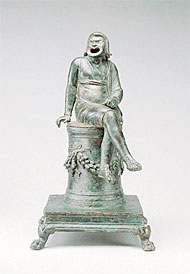 |
 |
 |
 |
Grades/Level: Middle School (6–8)
Subjects: Visual Arts, Theater
Time Required: 3–5–Part Lesson
Four 50-minute class periods
Author: J. Paul Getty Museum Education Staff
Permissions: 
The lesson plan and downloadable materials on this page are licensed under a Creative Commons Attribution 4.0 International License. |
 |
|
 |
 |
 |
 |
 |
 |
 |
Lesson Overview |
 |
Students will examine and discuss an ancient Roman incense burner and an ancient Greek statuette, both depicting comic actors, and an ancient Roman lamp decorated with a comic theater mask. They will learn how to play the improvisational games "What Are You Doing?" and "Freeze." They will then create costume props to develop a character. |
 |
 |
 |
 |
 |
Learning Objectives |
 |
Students will be able to:
• learn how stock characters in antiquity and the present day are portrayed by exaggerating mannerisms, clothing, gestures, and other characteristics.
• analyze the gestures, expressions, and details in ancient works of art depicting comic actors.
• create theater masks for stock characters.
• create costume props from recycled and everyday materials.
• use gestures and voices to convey scenes with stock characters. |
 |
 |
 |
 |
 |
 |
 |
 |
 |
Materials |
 |
• Reproduction of Incense Burner Shaped as a Comic Actor Seated on an Altar by an unknown Roman artist
• Reproduction of Statuette of a Comic Actor by an unknown Greek artist
• Reproduction of Lamp in the Shape of a Comic Mask by an unknown Roman artist
• Background Information and Questions for Teaching about the incense burner, statuette, and lamp
• Student Handout: "'Freeze' Rules"
• Materials for making masks (see Materials list for Beginning-Level Lesson)
• Information and activities in the "Understanding Formal Analysis" section on the Getty website (optional)
• Pencils
• An object that displays a comic actor or character (i.e., SpongeBob SquarePants pencil holder) and a figurine or doll of a comic actor or cartoon character
• Recycled cardboard or cereal boxes
• Scissors
• Aluminum foil |
 |
 |
 |
 |
 |
|
|
 |
 |
 |
 |
 |
Lesson Steps |
 |
Download the complete lesson by clicking on the "download this lesson" icon above.
Glossary Terms:
Words in bold on these pages and in the lesson are defined in the glossary for this curriculum (see "Performing Arts in Art Contents" links above). |
 |
 |
 |
| Incense Burner Shaped as a Comic Actor Seated on an Altar, unknown Roman artist, A.D. 1–50 |
 |
|
 |
 |
 |
 |
 |
 |
 |
 |
 |
 |
 |
Standards Addressed |
 |
Common Core Standards for English Language Arts
Grades 6–8
SPEAKING AND LISTENING
Comprehension and Collaboration
1. Prepare for and participate effectively in a range of conversations and collaborations with diverse partners, building on others' ideas and expressing their own clearly and persuasively.
2. Integrate and evaluate information presented in diverse media and formats, including visually, quantitatively, and orally.
Visual Arts Content Standards for California Public Schools
Grade 6
4.0 Aesthetic Valuing
4.1 Construct and describe plausible interpretations of what they perceive in works of art.
Grade 7
2.0 Creative Expression
2.1 Develop increasing skill in the use of at least three different media.
4.0 Aesthetic Valuing
4.2 Analyze the form (how a work of art looks) and content (what a work of art communicates) of works of art.
Grade 8
4.0 Aesthetic Valuing
4.3 Construct an interpretation of a work of art based on the form and content of the work.
Theatre Content Standards for California Public Schools
Grade 6
2.0 Creative Expression
2.1 Participate in improvisational activities, demonstrating an understanding of text, subtext, and context.
Grade 7
2.0 Creative Expression
2.1 Use improvisation in rehearsal to discover character and motivation.
Grade 8
2.0 Creative Expression
2.2 Perform character-based improvisations, pantomimes, or monologues, using voice, blocking, and gesture to enhance meaning.
|
 |

|
 |
 |
 |





